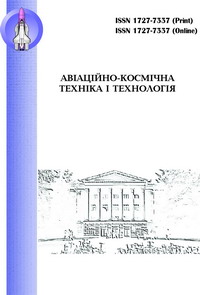Моделювання процесу парашутування літака на злітно-посадкову смугу при його посадці

View/
Date
2024Author
Капітанова, Л.В.
Рябков, В.І.
Кірносов, Д.С.
Metadata
Show full item recordAbstract
Посадка літака є невідомою частиною його польоту і на цьому етапі спостерігається найбільша кількість аварій і навіть катастроф. Слід зазначити, що рух літака на його повітряних ділянках, коли він знаходиться під впливом аеродинамічних сил, гравітація і тяги двигунів, досить точно моделюються різними авторами що представлені в друкованих джерелах. Недостатньо вивчено особливості руху літака по повітряно-наземній посадці, тобто в момент парашутування безпосередньо на злітно-посадкову смугу. Зовсім мало вивчено вплив умов парашутування на стійкість післяпосадкового пробігу. Предметом вивчення в статті є моделювання процесу парашутування в умовах приземлення літака при його посадці. Метою є розробка та випробування математичних та імітаційних моделей процесу руху літака в момент його парашутування від зони вирівнювання до злітної посадкової смуги і забезпечення стійкості поздовжнього руху у момент першого посадкового удару і подальшого руху. Завдання: проаналізувати особливості посадкових відстаней літаків транспортної категорії; встановити особливості парасейлінгової стадії літака при посадці; розробити параметричну модель літака в його парашутній конфігурації; встановити умови для моделювання амортизаційних стійок шасі; на основі загальних та імітаційних моделей встановити зони стійкості поздовжнього руху літака після першого приземлення. За результатами експериментальних досліджень отримано, що запропонована математична модель літака в посадковій конфігурації та імітаційна модель участі в посадці амортизаційних систем опор шасі досить достовірно (порівняно з експериментальними даними) оцінюють рух літака в момент його приземлення та на наступному пробігу. Це означає, що математичне моделювання дозволяє: уникати повторних підскоків при приземленні, забезпечити стійкість поздовжнього руху літака, скоротити довжину негальмівного пробігу і зменшити потрібну довжину ЗПС при посадці літака. Висновки: Шляхом аналізу нормованих посадок виявлено шість найхарактерніших етапів у посадковій дистанції літаків транспортної категорії. Запропоновано метод математичного моделювання руху літака на ділянці його парашутування на злітно-посадкову смугу, з урахуванням не тільки особливостей планера, але з урахуванням особливостей роботи амортизаційних систем шасі дозволяє оцінити параметри парашутування, які забезпечують стійкість поздовжнього руху літака після першого удару в опори шасі. На прикладі літака Ан-140 показано, як забезпечуються значення параметрів стійкості гальмівних коліс і як впливає швидкість парашутування на довжину його посадкової дистанції. The landing of an aircraft is an unknown part of its flight, and at this stage, the highest number of accidents and even disasters are observed. It should be noted that the movement of the aircraft in its airspace, when it is under the influence of aerodynamic forces, gravity, and engine thrust, is quite accurately modeled by various authors and presented in printed sources. The peculiarities of the aircraft’s movement during air-to-ground landing, i.e., at the moment of parachuting directly onto the runway, are insufficiently studied. The influence of parachuting conditions on post-landing stability has barely been studied. The subject of study in this article is the modeling of the parachuting process under conditions of aircraft landing. The goal of this study is to develop and test mathematical and simulation models of the aircraft’s movement during its parachuting from the alignment zone to the runway and to ensure the stability of longitudinal movement at the moment of the first landing impact and subsequent movement. Tasks: analyze the characteristics of the landing distances of transport category aircraft; establish the features of the parasailing stage of the aircraft during landing; develop a parametric model of the aircraft in its parachute configuration; establish conditions for modeling shock-absorbing landing gear; and, based on general and simulation models, establish zones of longitudinal movement stability of the aircraft after the first landing. Based on the results of experimental studies, the proposed mathematical model of the aircraft in landing configuration and the simulation model of participation in the landing of shock-absorbing landing gear systems quite reliably (compared to experimental data) estimate the aircraft’s movement at the moment of its touchdown and subsequent roll. This means that mathematical modeling can avoid repeated bounces during landing, ensure stability of longitudinal aircraft movement, reduce the length of the unbraked roll, and decrease the required runway length during aircraft landing. Conclusions: By analyzing normalized landings, the six most characteristic stages in the landing distance of transport category aircraft have been identified. A method of mathematical modeling of aircraft movement during parachuting onto the runway, considering not only the glider’s characteristics but also the features of the landing gear shock-absorbing systems, allows evaluating the parameters of parachuting that ensure stability of longitudinal aircraft movement after the first impact on the landing gear. Using the example of the An-140 aircraft, it is demonstrated how the values of brake wheel stability parameters are ensured and how the parachuting speed affects the length of its landing distance.
